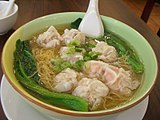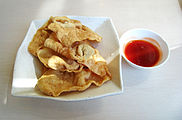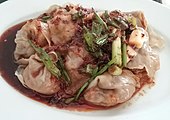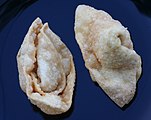Wonton
This article needs additional citations for verification. (May 2014) |
| Wonton | |||||||||||||||||||||||||||||||||||||||
|---|---|---|---|---|---|---|---|---|---|---|---|---|---|---|---|---|---|---|---|---|---|---|---|---|---|---|---|---|---|---|---|---|---|---|---|---|---|---|---|
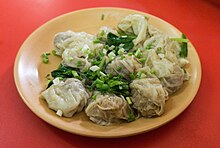 A plate of steamed wontons | |||||||||||||||||||||||||||||||||||||||
| Traditional Chinese |
| ||||||||||||||||||||||||||||||||||||||
| Simplified Chinese |
| ||||||||||||||||||||||||||||||||||||||
| Literal meaning |
| ||||||||||||||||||||||||||||||||||||||
| |||||||||||||||||||||||||||||||||||||||
| Part of a series on |
| Chinese cuisine |
|---|
 |
A wonton (traditional Chinese: 餛飩; simplified Chinese: 馄饨; pinyin: húntun; Jyutping: wan4 tan4) is a type of Chinese dumpling commonly found across regional styles of Chinese cuisine. It is also spelled wantan or wuntun in transliteration from Cantonese 雲吞 / 云吞 (wan4 tan1) and wenden from Shanghainese 餛飩 / 馄饨 (hhun den). Even though there are many different styles of wonton served throughout China, Cantonese wontons are the most popular in the West due to the predominance of Cantonese restaurants overseas.
Wontons, which have their origins in China, has achieved significant popularity as a sought-after delicacy that is not only celebrated and enjoyed in East Asian cuisine, but also across various Southeast Asian culinary traditions as well.
History
[edit]Yang Xiong from the western Han dynasty mentioned "bing wei zhi tun", which means wontons are a type of bread.[citation needed] The difference is that wontons have fillings inside and are eaten after being steamed or boiled.
The ancient Han Chinese thought wonton were a sealed bun, lacking "qi qiao" ('seven orifices'). So it was called "hun dun" (混沌), which means 'turbidity' or 'chaos'. Based on the Chinese method of making written characters, the radicals are changed from water to food; then, they became "hun tun" (餛飩, wonton in Cantonese). At that time, wonton had no difference from dumplings.[citation needed]
For centuries, the popularity and affinity of dumplings had not changed among the Han Chinese, but wontons eventually became popular in southern China and developed a distinct culinary style. From the time of the Tang dynasty, the Chinese began to differentiate the names of dumplings (jiaozi) and wontons.[1]
Differences from jiaozi
[edit]Wontons resemble jiaozi (餃子) dumplings but usually have less filling and are wrapped in a thin 6 × 6 cm yellow square dough wrapper or an isosceles trapezoid and folded into a triangular shape resembling a Chinese gold ingot known as yuanbao (元寶). Jiaozi are wrapped in a slightly thicker circular white dough wrapper with more filling and either flat or pleated edges.
The wonton dough wrapper is sometimes referred to as a wonton skin[2] and becomes transparent after being thoroughly boiled. It takes a shorter time to boil a wonton. The texture is also very smooth.
Wontons are traditionally served in soup, but jiaozi is usually eaten with dipping sauce.[3]
Preparation and filling
[edit]Wontons are made by spreading a square wrapper (a dough skin made of flour, egg, water, and salt)[4][5] flat in the palm of one's hand, placing a small amount of filling in the center and sealing the wonton into the desired shape by compressing the wrapper's edges together with the fingers. Adhesion may be improved by moistening the wrapper's inner edges, dipping a fingertip into water, and running it across the dry dough to dissolve the extra flour. As part of the sealing process, the air is pressed out of the interior to avoid rupturing the wonton from internal pressure when cooked.
The most common[6] filling is ground pork or chicken and shrimp with a small amount of flour added as a binder. The mixture is seasoned with salt, spices, and often garlic or finely chopped green onion. Factory-made, frozen varieties are sold in supermarkets. Commonly, they are handmade at the point of sale in markets or small restaurants by the proprietor while awaiting customers. In markets, they are sold by the unit without being pre-cooked.
Shapes and cooking methods
[edit]Wontons are commonly boiled and served in soup or sometimes deep-fried. There are several common regional variations of shape.
The most versatile shape is a simple right triangle, made by folding the square wrapper in half by pulling together two diagonally opposite corners. Its flat profile allows it to be pan-fried like a guotie (pot sticker) in addition to being boiled or deep-fried.[citation needed]
A more globular wonton can be formed by folding all four corners together, resulting in a shape reminiscent of a stereotypical hobo's bindle made by tying all four corners of a cloth together.
A related kind of wonton is made by using the same kind of wrapper but applying only a minute amount of filling (frequently meat) and quickly closing the wrapper-holding hand, sealing the wonton into an unevenly squashed shape. These are called xiao huntun (literally "little wonton") and are invariably served in a soup, often with condiments such as pickles, ginger, sesame oil, and cilantro (coriander leaves).[citation needed]
Cuisine
[edit]Each region of China has its own variations of wonton; examples include Beijing, Sichuan, Hubei, Jiangnan, Jiangxi, Guangdong (Canton), and Fujian.
Dumplings and wontons from the 7th and 8th centuries CE were found in Turpan.[7]
Cantonese cuisine
[edit]In Cantonese cuisine, shrimp-filled wontons within minced pork are most commonly served with thin noodles in a steaming hot soup to make wonton noodles. It may also be consumed with red vinegar. The soup is made from boiling shrimp shells, pork bones, and dried flounder to give it a distinct taste. Wontons are served in a variety of sizes, with the smallest being two wontons and noodles called sai yung.[citation needed]
Sichuan cuisine
[edit]In Sichuan, semi-pentagonal wontons are known as "folded arms" (Chinese: 抄手; pinyin: chāo shǒu) since after initially folding the wonton skin into a right triangle, each end of the hypotenuse is pressed against the middle of opposite sides, creating an impression of crossed arms/hands. These are often served in a sesame paste and chili oil sauce as a dish called "red oil wonton" (Chinese: 红油抄手; pinyin: hóng yóu chāo shǒu).[8]
Shanghai cuisine
[edit]In Shanghai and its surrounding area (Jiangnan, nowadays Yangtze River Delta), wonton filling is most often made with minced meat (usually pork) and shepherd's purse served in chicken soup; however, Shanghai cuisine makes a clear distinction between small wontons and large wontons. The former are casually wrapped by closing the palm on a wrapper with a dab of pork filling as if crumpling a sheet of paper. These are popular accompaniments to breakfast or brunch fare. The "large" wontons are carefully wrapped in a shape similar to tortellini, and a single bowl can serve as lunch or a light dinner. They are available with a large variety of fillings; a popular Shanghai fast-food chain offers more than 50 varieties. One popular variety in Shanghai that originated in Suzhou is "three delicacies wonton" (san xian hun tun), which contains pork, shrimp, and beef liver as primary ingredients.
Ningbo cuisine
[edit]Ningbo wontons come in two types, steamed wontons and wonton soup.[9] Both are filled with pork and shrimp.[10] These wontons became popular at many Chinese-American restaurants due to their traditional preparation.
Jiangzhe cuisine
[edit]Jiangsu are often called "wonton." Wontons have two types, small wontons, and big wontons. Big wontons are a large ingot shape. Generally boiled, the soup will usually be matched with a thin egg omelette, seaweed, mustard greens, and shrimp.[citation needed]
Outside China
[edit]In American Chinese cuisine (and occasionally in Canada as well), wontons are served in two ways: in wonton soup (wontons in a clear broth) and as an appetizer called fried wontons. Fried wontons are served with a meat filling (usually pork) and eaten with duck sauce, plum sauce, sweet and sour sauce, or hot mustard. A version of fried wontons filled with cream cheese and crab filling is called crab rangoon. Another version of fried wontons is filled with cream cheese, green onions, soy sauce, and garlic.
Wonton strips, deep-fried strips made from wonton wrappers and served with hot mustard or other dipping sauce, are a common complimentary appetizer in American-style Chinese restaurants.
In the Philippines, fried wontons are often called pinseques fritos (pinsec frito in the Castilian singular).[11] Pritong pinsek is the Cebuano and Tagalog name. It also figures in the noodle soup pancit Molo, named after the Molo district of Iloilo City.[12] Wonton wrappers in the broth serve as the noodles in the dish.
Wonton is commonly eaten in Singapore as part of the country's hawker culture. It is commonly eaten with noodles and are called dry wanton mee.
In Indonesian Chinese cuisine, they are called pangsit and are served fried or in soup, usually with Chinese noodles.
In Peruvian-Chinese gastronomic fusion called Chifa, wontons, called wantán in Peru, can be found fried with meat filling to eat with rice or Tallarín saltado, and also in wonton soup or sopa wantán.
In Thailand, wontons are called kiao (เกี๊ยว, pronounced [kía̯w]), from the Teochew pronunciation of 饺 (Mandarin: jiǎo; "dumpling"). Wonton soup is called kiao nam (เกี๊ยวน้ำ, [kía̯w náːm]); the soup is made with chicken stock and the wontons made with a pork filling. The soup is very famous in Thailand.
In Eastern Europe, mainly Russia (where they are called пельмени pelmenyi) and Estonia (where they are called pelmeenid), wontons are usually filled with minced meat. They are either boiled or fried; many people eat them with vinegar and sour cream.
In Vietnamese cuisine, they are known as hoành thánh.[13]
Chinese culinary nomenclature
[edit]In Mandarin, they are called huntun (simplified Chinese: 馄饨; traditional Chinese: 餛飩; pinyin: húntun).
In Cantonese, they are called wantan (simplified Chinese: 云吞; traditional Chinese: 雲吞; Jyutping: wan4 tan1; Cantonese Yale: wàhn tān), which means "cloud swallow" because when they are cooked, the dumplings float in the broth like small clouds.[14][15]
In the Hokkien language, they are called Pián-si̍t (Chinese: 扁食; pinyin: Pián-si̍t).
Mythology
[edit]Hundun (混沌, close pronunciation to Hundun 馄饨) is also a legendary faceless being in Chinese mythology and the primordial and central chaos in Chinese cosmogony, comparable with the world egg.
Gallery
[edit]-
A bowl of wonton noodle soup (云吞面)
-
A plate of fried wontons called pangsit goreng (锦卤馄饨) with sweet and sour sauce, from Indonesian Chinese cuisine
-
Sichuan cuisine's red oil wontons (红油抄手)
-
Fried wontons from American Chinese cuisine
-
Grilled wonton snack
See also
[edit]References
[edit]- ^ "馄饨的由来:古代人认为是一种密封的包子". Archived from the original on 8 January 2020. Retrieved 25 June 2019.
- ^ Bladholm, L. (1999). The Asian Grocery Store Demystified. Take It with You Guides. St. Martin's Press. p. 192. ISBN 978-1-58063-045-0. Retrieved 4 January 2020.
- ^ "馄饨与饺子有什么区别?".
- ^ Wonton Wrappers Archived 22 September 2014 at Wikiwix About.com. Retrieved: 28 February 2012.
- ^ Homemade Wonton Wrappers Archived 29 February 2012 at the Wayback Machine Kitchen Simplicity. 13 October 2009.
- ^ "Wonton Soup". 29 September 2018.
- ^ Hansen 2012, p. 11.
- ^ Holland, Mina (2014). The Edible Atlas: Around the World in Thirty-Nine Cuisines. Edinburgh: Canongate Books. p. 275. ISBN 978-0-85786-856-5. Archived from the original on 2 May 2018.
- ^ "Wonton soup Recipe". simplechinesefood.com.
- ^ "Steamed Wonton and wonton soup". chinatravelz.com. Archived from the original on 31 December 2017. Retrieved 2 May 2018.
- ^ "Comida China de Manila". www.comidachinademanila.com. Archived from the original on 4 October 2017. Retrieved 2 May 2018.
- ^ "Iloilo rising: Hometown of pancit molo, Jose Mari Chan & Grace Poe". The Philippine Star. Retrieved 3 February 2016.
- ^ Avieli, Nir. Rice Talks: Food & Community in a Vietnamese Town.
- ^ "Swallowing clouds in water". Archived from the original on 12 May 2016. Retrieved 28 April 2016.
- ^ "A wonderful wonton soup recipe". Archived from the original on 28 April 2016. Retrieved 28 April 2016.
- American Chinese cuisine
- Australian Chinese cuisine
- Beijing cuisine
- Canadian Chinese cuisine
- Cantonese dumplings
- Cantonese words and phrases
- Chinese dumplings
- Fujian cuisine
- Hong Kong cuisine
- Hubei cuisine
- Indonesian Chinese cuisine
- Shanghai cuisine
- Sichuan cuisine
- Malaysian cuisine
- New Zealand Chinese cuisine
- Singaporean cuisine

